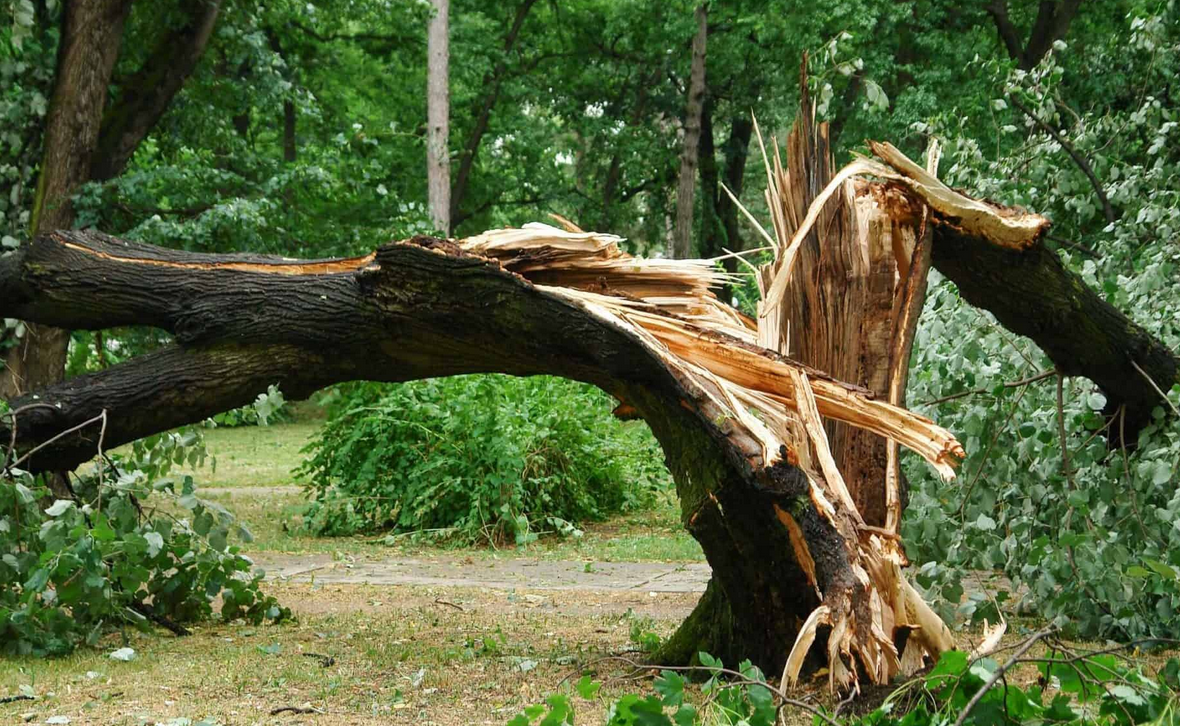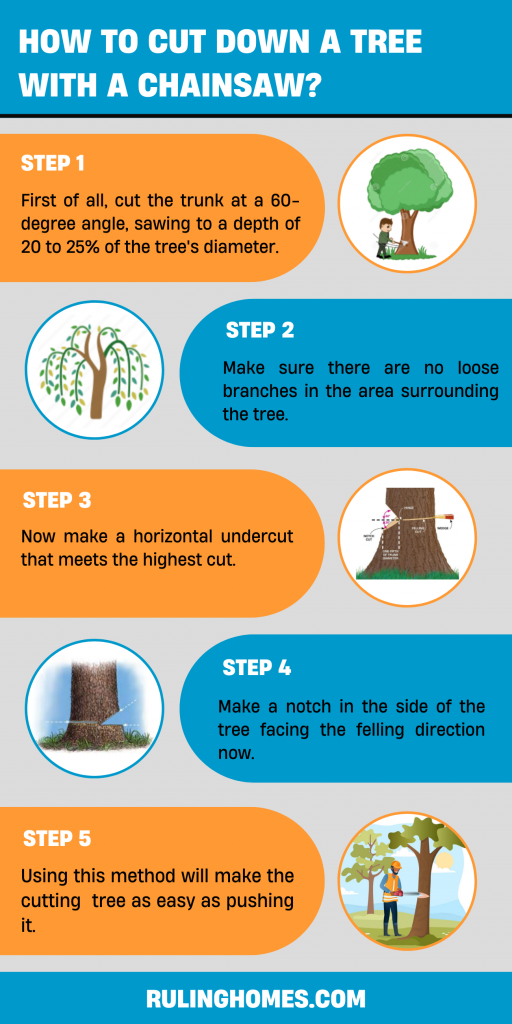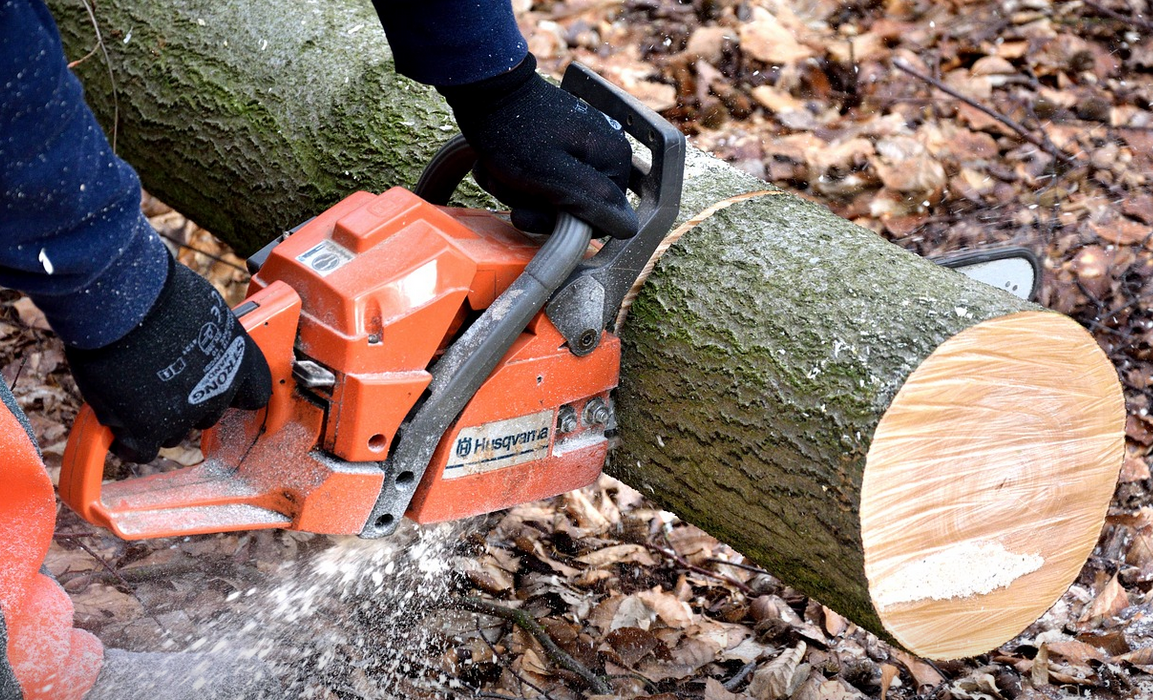Cutting down a tree with a chainsaw involves a few steps.
-
- First of all, you have to cut the trunk of the tree at a 60-degree angle, sawing to a depth of about 20 – 25% of the tree’s diameter.
- Now make a horizontal undercut that meets the highest cut.
- Now you need to have a notch to carve out of the side of the tree facing the felling direction now.
- This is the easiest way to cut down a tree as these cuts will make the tree feel with just a push.
Table of Contents
Safety for Cutting Down a Tree
Think about safety first. When preparing to fell a tree.
Check out where the tree is standing and what objects are around it. Houses, barns, power lines, fences, and other structures are often damaged due to falling trees.
If there are roads located in the zone, use warning signs while using the chainsaw. If you’re a beginner and there are objects near, get an experienced person to help with the felling of the tree.
Pay special attention to other trees also. Making a tree fell can have an impact on other trees, which will be smaller or weakened by tree rot and leaning.
Choose the chainsaw with perfect measurement for the purpose.
Decide What Direction to Fell a Tree
Once you’ve got familiar with your surrounding objects, check out the tree itself to work out what direction you can fell the tree.
If the tree is leaning in one direction, it’s better to fall the tree that way as long as there are no objects in the falling zone.
Wind speed also can affect the felling direction. Finally, consider the work involved in removing the tree once it’s fallen.
You also have to check if it will be easy or difficult for you to access the place in the fall zone.
Also Read: Best Miter Saw Stand
Step by Step Guide to Cut Down the Tree
Here is a complete guide to cut down a tree with a chainsaw (the process might be slightly different for the miter saw). Ensure that you have sharp chainsaw when you start the process:
Step 1: Inspect the Area
Start by surveying the area. You have to make sure that there are not any structures, power lines, or pets in a radius adequate to the tree’s peak.
Keep people at a distance that’s a minimum of double the peak of the tree. You need to have all of your tree-cutting tools available.
Step 2: Clear the Tree-Felling Work Area
The tree should fall in the direction the tree naturally leans. If you would like it to fall in another direction, contact a tree-felling professional.
The next step is to plan a clear escape path which needs to be opposite the direction of the fall and at a 45-degree angle. Clear the area around the tree, and confirm that there are not any loose branches overhead.
Step 3: Make the Primary Cut
With the tree on your left side and your left shoulder opposite to the tree, make a 70-degree cut on the side facing the direction you would like the tree to fall.
If your chainsaw features a felling sight on the housing, use it as a guide.
Pointing the sight where you would like the tree to fall will assist you in cutting it at the right location on the tree. Move a depth of a few quarters of the tree’s diameter.
Step 4: Make the Second Cut
For the second cut, turn the chainsaw sideways and cut horizontally to complete your first cut, creating a notch. Make sure both of the cuts meet.
Step 5: Make the Felling Cut with Tools
Move to the other side for the felling cut and make a horizontal cut slightly above the previous cut.
Saw until you’ve got enough room to insert a wedge into the move to keep the saw from binding.
Insert the tree-felling wedge into this cut, pointing at the direction you would like the tree to fall. Drive the wedge in and finish the cut while ensuring not to touch the felling wedge with the blade.
Don’t cross the trunk. Leave about 10% of the width as a hinge. When the tree prompts to fall, move away down your escape way.
You might like: How to Start a Stihl Chainsaw?
Limb and Buck the Tree
It is easy to cut down a tree with a chainsaw. However, treating the limbing and bucking processes with the maximum amount of care is important.
Anytime you’re working with a chainsaw, you have to use all safety precautions. To make removal easy or make great firewood, you’ll have to limb and buck the tree.
Limbing
Limbing is that the process of removing the branches from the felled tree.
You have to make sure the tree is on land before you start this process. You’ll prefer to use either bottom or the highest of the bar, whichever is most comfortable for you.
Start at the bottom of the tree and work your way upwards, safely removing limbs as you go. For particularly difficult branches, you’ll cut on one side, then the opposite, alternating until it’s completely removed.
If some limbs are bent under the tree, rotate the tree once you are through with all the limbs you’ll reach.
Be careful; these limbs may snap back as you turn the tree. If there are large branches under this tension type, start from the surface and work your way toward the trunk.
Bucking
Once you’ve removed the limbs, you need to have smaller logs. You can cut the tree into smaller logs through a process called bucking.
If a log is totally on the bottom, cut as far into the log as possible.
Then, rotate it to form the ultimate cut. If one end is elevated, you should start the cuts from the bottom and finish them on top. You’ll make your logs into whatever size is manageable for the equipment you’ve got.
Final Words
As we’ve seen, it’s important to settle on a chainsaw that’s the proper size for the work you would have to do.
Consider carefully the work you would like your chainsaw for and choose one that’s appropriate.
Calculate the diameter of the tree. Always inspect and clean the surrounded area before cutting down the tree. Prepare yourself well and make sure that all safety tools are available before cutting down the tree.

I grew up on a small farm in New Jersey. We had a big family because my parents, my uncles and aunties all were living together on this farm so, you can imagine, it was always over crowded with people. But living in farm was really great because we had to do everything on our own and I learned so many things from my parents and uncles and aunties and that is where I found my passion for fixing things, whether it is renovating or designing, I was always there. Read more



